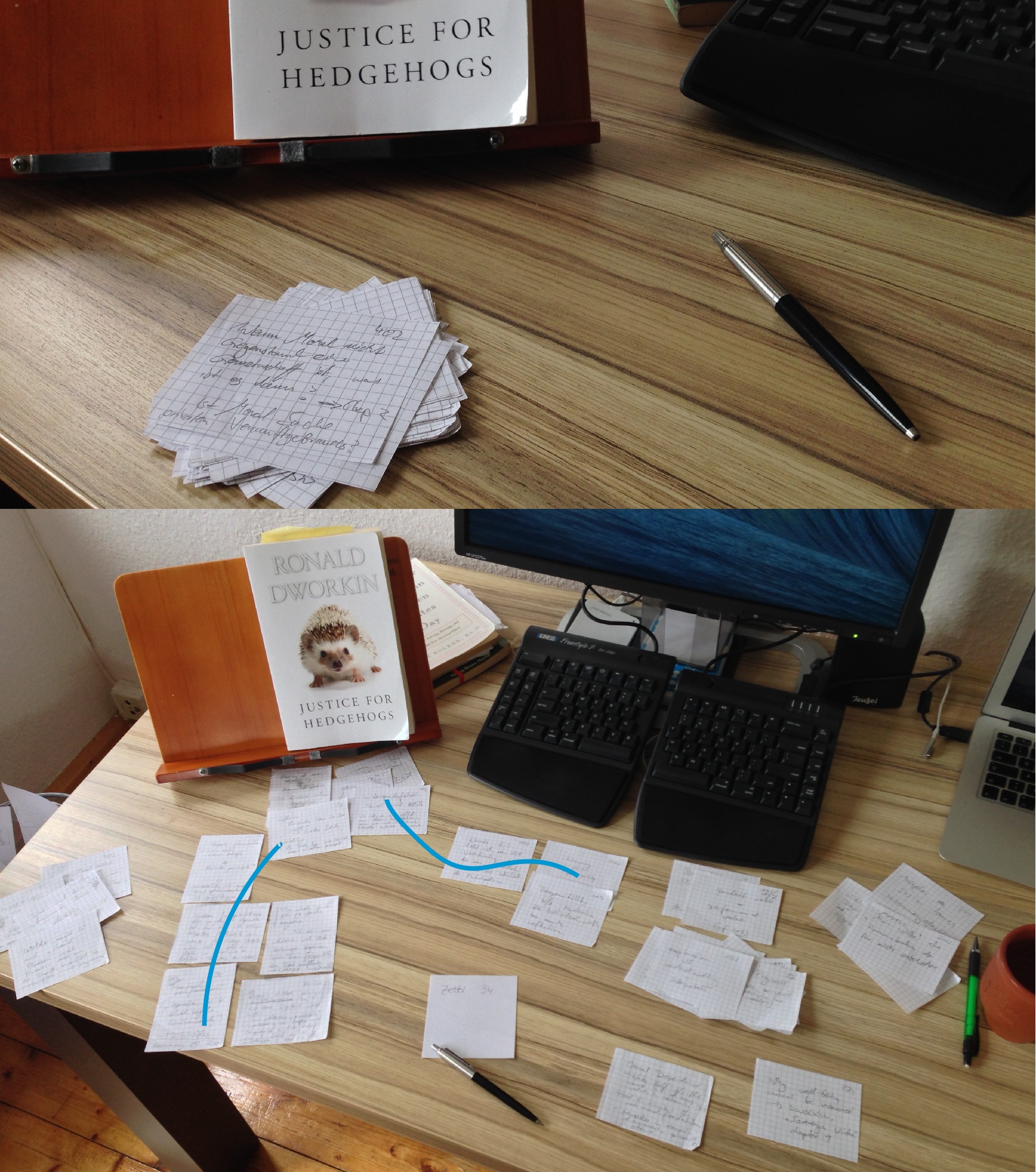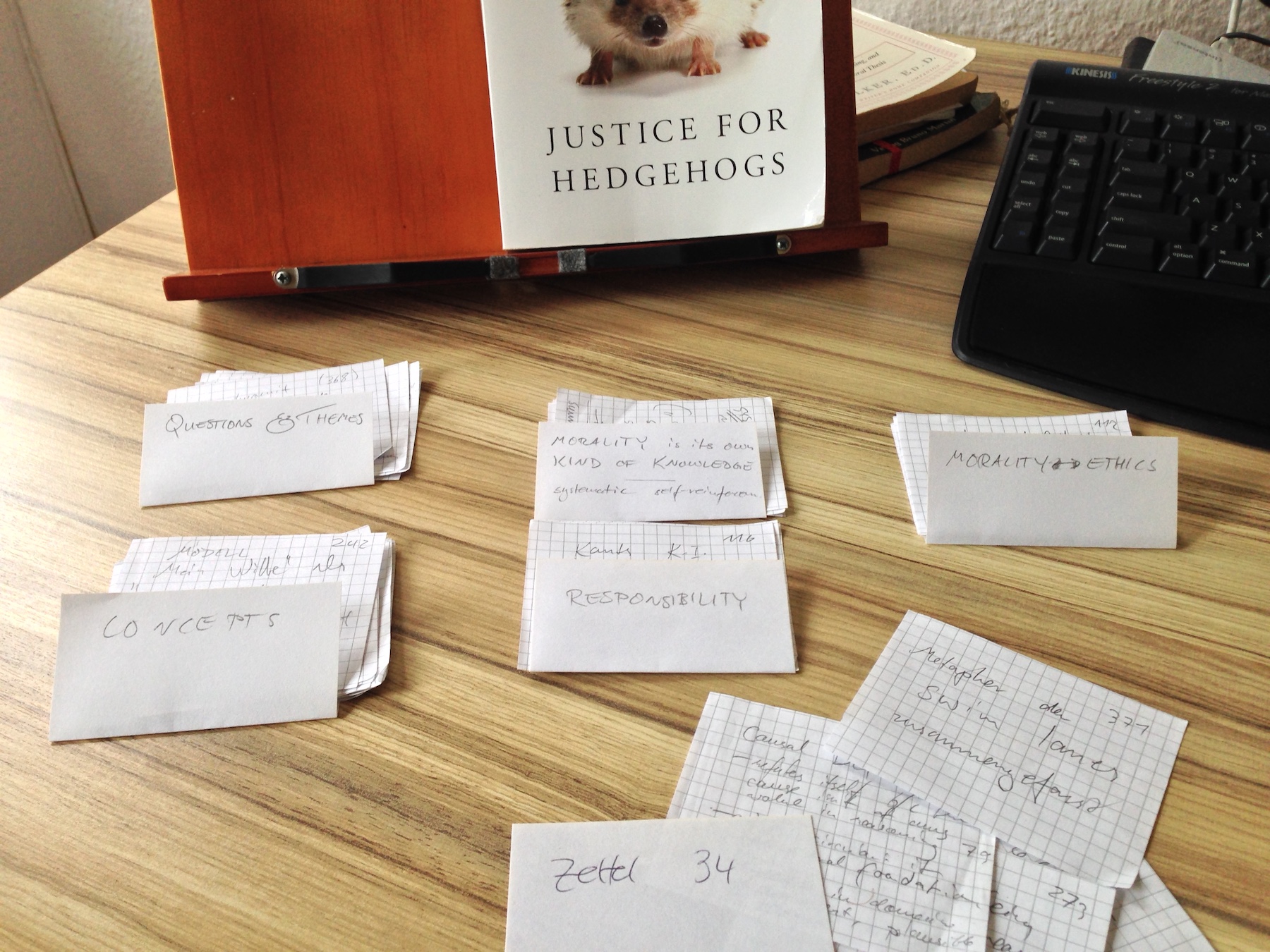How I Prepare to Work on a Research and Writing Project
How do I deal with reading and research projects for University? I plan and prepare the work. This is the second post of the Summer Knowledge Challenge: here, I tell you about the first step, extracting reading notes from Justice for Hedgehogs and preparing the project. The procedure I describe applies to other University assignments and writing projects as well.
Let me tell you what you’ll find in this post first.
I like to make plans. And I like to make actionable to-do lists. To create those, I find out what my work will be about before I do anything else. I get an overview of the material.
I prepare for the real work: deep research and writing for a long period of time. I know that I won’t finish the project in a matter of days or weeks. Instead, I assign a few months to the overall progress. That’s why I think preparing is so important: I have to ensure there’s a solid system in place to support my work. Writing, like a marathon, requires endurance. I prepare for every writing project in a similar manner. Conventions make my work predictable, and I have to think less about the wire-framing and can focus on the important stuff instead.
Don’t know what else I did in this series? Have a look at the other posts from the 2014 Summer Knowledge Challenge.
Getting an Overview: Bring Order to the Reading Notes

I count 34 notes in total, one idea, term, concept, or question for each note. That’s not much for a whole book, but it’s not too little, either, for I merely have skimmed the book’s contents.
Trying to group the notes thematically, I notice there are connections already. There are “bridges” between the groups. I drew blue lines into the picture so you know what I mean. One note for example is about a concept by Kant which connects “responsibility” to “morality”.

Afterwards, I create clusters of related notes and assign a working title to each of them. I end up with:
- a collection of questions,
- a collection of concepts or term definitions,
- a cluster about responsibility,
- a cluster about morality as its own kind of knowledge,
- a cluster about the connection of morality and ethics,
- and 4 assorted notes (one is a task reminder to look up a related book).
In the next step, I will organize my questions and afterwards begin to create Zettel notes from the clusters. Last year, I’ve already depicted how I create Zettel from reading notes. So this time, instead of going into further detail just yet, I’ll follow up with the project management stuff and focus on research questions and the like.
Preparing to Dive Deep: Project Management
I create a running list of ideas concerning Justice for Hedgehogs.1 I put topics in there which sound interesting enough to fill a term paper. Reading the book and working with it is a project, so it deserves some kind of representation in my knowledge system.
This step deserves some clarification, I feel. I want to be cautious so you don’t get the wrong impression: I use nvALT to manage all my Zettel notes. It’s the application I use to access the folder of text files which is my Zettelkasten note archive. In the same folder, there are notes which aren’t Zettel notes, like running lists I keep there because it’s convenient to access them this way. For example, I’ve got a list of movies I want to watch, or a list of blog posts I already published here. Running lists live rather long but are of no substantial value to my personal knowledge management. Additionally, there are shorter lived notes which do add extra value. Project notes are part of that. Think of these as scratchpads for a fully-fledged project organization. That’s what I initially want to create to get hold of the collection of questions.
After taking pictures of my reading notes, though, I find the project is already mature enough to warrant its own project folder. So the list of questions moves out of nvALT’s area of responsibility and into a new folder which I call “2014-09-26 phil Justice Hedgehogs”.
The “phil” part denotes that the project belongs to a philosophy class at University. I use another marker a lot, “MLZ”, to group my various projects at work, like “2014-06-16 MLZ Workshop PowerPoint”. This convention to put a marker like “MLZ” or “phil” into the file name right after the date helps me see at a glance where I decided to invest my energy.
All running project folders live inside a “Pending” folder, sitting in my Dropbox. There’s a “Defer” folder sitting next to it where I put stuff I’d like to work on but won’t right now, and there’s a “Project Archive” where I move some of the “Pending” stuff after completion and a bit of clean-up work.
In general, I deal with projects this way:
- I create a record in nvALT first to give the idea some time to marinate and to conveniently add details.
- If I decide how I want to proceed, I’ve got two options:
- When I take on the project, I create a project folder with additional information in “Pending”. The project folder either starts with the current date or with a deadline, so the topmost entries in “Pending” are either the most pressing or simply lay around the most.
- When I think it’s best to defer it until someday later, I put the material in a folder below “Defer” so my list of “Pending” projects doesn’t grow too big. In this case, instead of the current date I add when I want to look at it again, with year and month precision.
- After I finish a project, I move it into my “Project Archive”. Most of my client work sits there for documentary reasons. I store term papers in a “Study” folder instead, keeping the few LaTeX files and the PDF output together (or
.docxand PDF if I were to write something in Microsoft Word, for example). In general, I always keep a snapshot of the version I handed in next to a copy I can edit.
So in this case I end up with the active project “2014-09-26 phil Justice Hedgehogs”. In there, I put a collection of pictures of my reading notes and the aforementioned list of research questions, called – wait for it! – “201409261640 research questions.md”. The .md file type stands for Markdown plain text. Because I don’t expect that file to change substantially (adding a question or two is no substantial change), I gave it a stable and unique identifier, based on the current date and time. The research questions I collected are the following ones:
- How did Dworkin coin the concept of dignity in chapter 9? [368]
- Which “ought to”s and “should”s does Dworkin use to connect his concepts morally? (Create a diagram)
- Why is it of objective importance to lead a Good Life? [196]
- If it’s forbidden to lie because you’d influence other people’s autonomous decision-making process with false information, do you have to say a lot of true things whenever possible to increase the overall degree of information among people?
- If morality isn’t owned by a community, to whom does it belong instead? [402, see chapter 2]
- Is morality subject to private reasoning? (Kant’s term)
The accompanying reading notes on paper find their way into the trash. 29 reading notes left to go.
Takeaway: How I Work
Let me sum up my preparation:
- I take notes on paper while reading. If you’re into pen-and-paper tool porn: I keep a Faber-Castell .5mm mechanical pencil and a simple perforated note pad with me all the time, both fitting into a front pocket of my trousers. It’s my take on the famous ubiquitous capturing device. I take note of my thought and the page which sparked it. I put little dots in the margin of the page to make finding the inspiring passage easily later on.
- When I finish a book, I take out all my reading notes and cluster them.
- I create a project representation. Sometimes, a simple text file suffices. This time, I create a project folder to keep accompanying material like pictures next to the project notes. Even if this wasn’t a special “look behind the scenes” writing project, I’d later on create a project folder to keep my outlines and the drafts of the paper organized.
- Up next, I will create the usual Zettel notes in my Zettelkasten note archive, probably starting with the terms and concepts because they are most atomic: they wont’t depend on a lot of other stuff taken from the book.
I put the draft of this post into the project folder, too. This time, I will not delete the draft after publishing because I want to have an overview of stuff I created for this project. Consequently, I copy my announcement post into the project folder, too, calling it “2014-07-31 challenge apply the knowledge cycle.md”.
- How are you doing so far in this challenge? What’s your first step when you tackle a book?
- If you still want to join, put an announcement and a link to your blog or website into the comments so I can add you to the list of participants.
- See the other posts from the 2014 Summer Knowledge Challenge.
-
Affiliate links; I get a small kickback from the vendor if you buy from my link but it won’t cost you anything. ↩